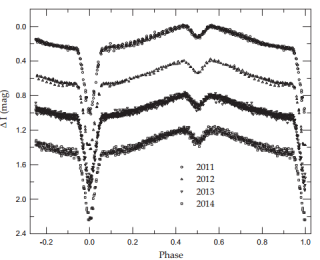 We searched for circumbinary planets orbiting NY Vir in historical eclipse times including our long-term CCD data. Sixty-eight times of minimum light with accuracies better than 10 s were used for the ephemeris computations. The best fit to those timings indicated that the orbital period of NY Vir has varied due to a combination of two sinusoids with periods of P3=8.2 yr and P4=27.0 yr and semi-amplitudes of K3=6.9 s and K4=27.3 s, respectively. The periodic variations most likely arise from a pair of light-time effects due to the presence of third and fourth bodies that are gravitationally bound to the eclipsing pair. We have derived the orbital parameters and the minimum masses, M3sini3 = 2.8 MJup and M4sini4 = 4.5 MJup, of both objects. A dynamical analysis suggests that the outer companion is less likely to orbit the binary on a circular orbit. Instead we show that future timing data might push its eccentricity to moderate values for which the system exhibits long-term stability. The results demonstrate that NY Vir is probably a star-planet system, which consists of a very close binary star and two giant planets. The period ratio P3/P4 suggests that a long-term gravitational interaction between them would result in capture into a nearly 3:10 mean motion resonance. When the presence of the circumbinary planets is verified and understood more comprehensively, the formation and evolution of this planetary system should be advanced greatly.
We searched for circumbinary planets orbiting NY Vir in historical eclipse times including our long-term CCD data. Sixty-eight times of minimum light with accuracies better than 10 s were used for the ephemeris computations. The best fit to those timings indicated that the orbital period of NY Vir has varied due to a combination of two sinusoids with periods of P3=8.2 yr and P4=27.0 yr and semi-amplitudes of K3=6.9 s and K4=27.3 s, respectively. The periodic variations most likely arise from a pair of light-time effects due to the presence of third and fourth bodies that are gravitationally bound to the eclipsing pair. We have derived the orbital parameters and the minimum masses, M3sini3 = 2.8 MJup and M4sini4 = 4.5 MJup, of both objects. A dynamical analysis suggests that the outer companion is less likely to orbit the binary on a circular orbit. Instead we show that future timing data might push its eccentricity to moderate values for which the system exhibits long-term stability. The results demonstrate that NY Vir is probably a star-planet system, which consists of a very close binary star and two giant planets. The period ratio P3/P4 suggests that a long-term gravitational interaction between them would result in capture into a nearly 3:10 mean motion resonance. When the presence of the circumbinary planets is verified and understood more comprehensively, the formation and evolution of this planetary system should be advanced greatly.
Authors: Jae Woo Lee, Tobias Cornelius Hinse, Jae-Hyuck Youn, Wonyong Han

